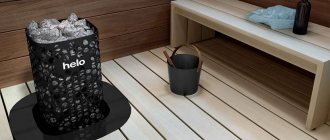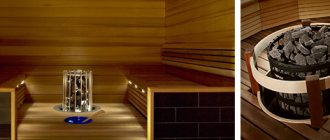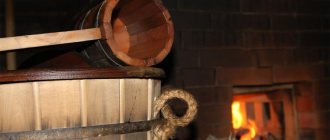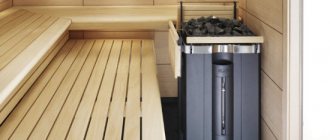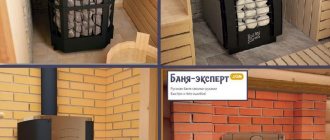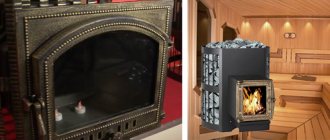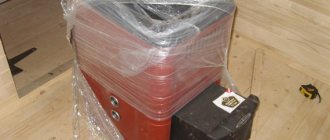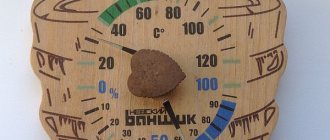Building a bathhouse or sauna for your private home or country house is the dream of many owners of such properties. Ready-made solutions offered on the market very rarely satisfy the needs of the domestic buyer. There is always the opportunity to build your own room system and choose a stove for a bath that will provide a comfortable temperature and ease of use. If everything is done correctly, you can get an excellent steam room for a pleasant and healthy vacation.
The importance of careful calculations
Regardless of what type of stove is installed in the bathhouse, double-circuit wood-burning, electric, metal or brick, you need to correctly calculate its parameters. It is worth giving clear examples of the importance of the characteristics of a heating unit.
- If you choose the wrong stove for a sauna by volume, it will be impossible to achieve ideal steam. If the installation power is insufficient, it is simply impossible to warm up the room.
- An equally unpleasant situation is when the design of a sauna stove deliberately overestimates its power. The steam room will constantly overheat. Therefore, we will have to ventilate it and make visits shorter.
- If you choose too large a furnace volume and quantity of stone for a wood-burning sauna, it will be impossible to obtain stable steam. Without ventilation, the room will become extremely hot. And if you achieve relative comfort by opening the doors and reducing the entry time, you will have to put up with changes in the temperature of the steam, both at the floor and on the top shelf.
There are other difficulties caused by incorrect calculations. In particular, certain algorithms for determining the mass of stones can force the owner of a bathhouse to build powerful supports - scales, the task of which is to withstand significant loads. Therefore, the calculation of the power of a sauna stove must be done carefully, taking into account the nature of the steam room: Russian bath or Finnish sauna.
“Incorrect” sauna stove power
The power of the heater should be optimal, no more, no less. The issue of heater power can be neglected only in one case: if you have built a hammam, where there is no sauna stove in the usual sense.
If the power of the heater is not selected correctly, this will inevitably lead to certain troubles.
Excess power
Some people choose a sauna stove with a large power reserve so that the steam room heats up faster. Yes, in this case the steam room will actually heat up faster, but this is only the initial stage, and then the stove will work at a minimum.
As a result, you will get hot air, but cold stones on which it is useless to pour water - they will not produce steam, and if there is steam, it will be clouds of white steam, like over a kettle, and not the light transparent steam that you were counting on , building a bathhouse with your own hands or ordering its construction on a turnkey basis.
Lack of power
The other extreme is to buy a minimum power sauna stove in order to simply save money. Even if such a stove is able to heat the steam room to the required temperature, working at the limit, the heater will quickly fail.
Back to contents
Calculations for a Russian bath
A Russian bath always involves the use of a large amount of hot steam. In this mode, it is important to take into account each of the factors of circulation and conversion of thermal energy. In the bathhouse, it is necessary to ensure uniform heating conditions, both at floor level and on the upper shelves.
Calculating the power of a stove for a Russian bath takes into account not only the basic energy output for heating the volume of the room, but also the heat loss factors existing in the steam room . To determine the required heating device performance, you must:
- Calculate the total volume of the steam room. To determine it for a room with a rectangular floor, just multiply the width, height, and length of the room. If the steam room has a complex shape, its volume must be divided into separate parallelepipeds and their indicators must be summed up.
- If the room has brick walls, you need to take into account the additional power to heat this heat-intensive material. To do this, calculate the area of the masonry and take an additional volume of cubic meter for each square meter. m.
Then the complex processes of calculating heat loss begin. For single glass windows, you need to add 3 cubic meters to the total heating volume for every square meter of its area. In the case of double glazing, this figure is 1.5 cubic meters per square. Next, the increase in heating volume for doors is calculated. To do this, add 1.2 cubes per square of their area.
The next step is an adjustment for general insulation. If the bathhouse was built according to the basic recommendations, with mandatory waterproofing of the walls and gluing of finishing joints, there is no need to make changes to the already calculated volume for heating. In the case where a simple room without special insulation is allocated for a steam room, you should add 20 to 30% to the final cubic footage.
The last tolerance takes into account the nature of the heating. If the stove is located in an adjacent room, it is required to add another 10% to the final figure of the calculated volume. The resulting value is the minimum acceptable indicator.
Advice! In general, calculating the power of a sauna stove is very simple. It is enough to assume that heating one cubic meter of volume requires 1 kW of thermal energy. This is true for a Russian-style bathhouse.
Additional selection criteria
Power is the main criterion, but far from the only one. What types of sauna stoves are there? In order for the result to fully meet our expectations, we need to consider the following:
- product material;
- firebox design options;
- steam type;
- various designs;
- type of heater;
- operating time from one fuel fill;
- features of heating the bath;
- what fuel is used.
Only taking all this into account can you determine which sauna stove is better.
Material of manufacture
A sauna stove can be made from:
- cast iron;
- become;
- bricks
Which stove for a bathhouse is better, taking into account the material of manufacture? It is not entirely correct to compare them with each other. Each material better solves a particular problem and, according to experts, creates a special atmosphere.
With a modern range of furnace equipment, experts give the palm to special heat-resistant alloy steel with the addition of chromium. Steel, by far, is the most reliable and durable. The atmosphere in the bathhouse does not suffer either. Such furnaces do not burn oxygen, since during combustion there is no oxidation process in them.
When choosing reliable sauna stoves, the website pechnoy.guru recommends paying attention to Finnish companies. They deservedly occupy a leading position in this market. Their products have one drawback - their high price. Although, the same “Harvia” also produces quite budget models.
Sauna stove from Harvia
The production of cast iron stoves is not particularly popular today. The disadvantage of a cast iron stove is its heavy weight and shorter service life compared to the previous version. Heating occurs more slowly. This is worth taking into account when deciding which stove to choose for a bath.
Cast iron stoves are not very popular today
Choosing a brick stove is a tribute to tradition. Installing this is very labor-intensive. There weren’t many good craftsmen before. Now you won't find it at all. You can try to build a stove yourself, but is it necessary? This work is not easy - you need to correctly build the foundation and chimney, and the result will clearly be inferior to modern industrial designs. Brick requires more energy to warm up, so fuel consumption will increase.
At the same time, although such a stove will take longer to heat, it will also give off heat much longer. It all depends on your financial capabilities and personal preferences - sometimes such a stove is a good choice.
The brick option is long, expensive, and difficult.
Features of the firebox location
The firebox can be located in a closed steam room, but it is much more convenient when it is remote. This complicates the selection of a cast iron, steel or brick stove. You can add fuel at any time without disturbing those in the steam room. This slightly reduces the thermal insulation of the bath, but not critical. New thermal insulation of all junctions and seams will solve this problem. But the door to the steam room will open less often.
The new firebox door, made of heat-resistant glass, will allow you to monitor fuel consumption. The remote firebox itself must be made of thick heat-resistant steel with the addition of chromium. This design is an indicator of quality; it will not burn out for years and will withstand the highest temperatures.
Steam source
First, let's figure out what kind of steam exists. There are:
- Dry steam is the most beneficial for the body. The stones heat up to +5000C. Once you splash warm water on them, it instantly turns into steam. This steam evenly heats the entire bath and does not increase humidity.
- Wet steam - occurs as a result of boiling water directly in the bath. Hot water is also heated by a heater, which is equipped with a water tank. This method does not require a hot water supply. For washing, use water directly from the boiler. It is also a heat exchanger.
How to choose a stove for a bath correctly and quickly in this case? Fans of wet steam can organize a similar process in a sauna. There is no need to install a boiler with water for this. It is enough to buy a special device that will produce steam. The principle is the same, only the steam generator runs on electrical energy.
Design requirements
When choosing a stove for a bathhouse, you need to take into account the requirements for the design of the stove. She must:
- ensure gradual and uniform heating of the bath;
- heat the room to +800C (under the ceiling) in 3 hours;
- ensure adequate fire safety;
- eliminate the possibility of smoke and soot getting into the bathhouse;
- heat the stones to +5000C;
- provide ease of use;
- have an aesthetic appearance.
These are the minimum requirements. Everything else depends on your desire and financial capabilities.
Calculation for sauna
A classic sauna does not imply the generation of a large amount of water vapor in the steam room. This is the so-called dry heat. This is why the Finnish sauna is so popular among consumers. Solutions for its organization can be found in a huge range on the mass market.
Important! A classic sauna can be arranged even within an apartment. At the same time, there will be no need for special insulation and waterproofing in the room.
A small amount of water vapor can be generated for personal enjoyment. That is why even ready-made electric stoves for Finnish saunas are equipped with stones. However, this thermal energy conversion process may be considered insignificant and ignored.
What kind of stove to put in a sauna-type bathhouse, where you don’t need a large amount of steam, volume for people to move and wave brooms, is decided by its owner. You can go the hard way. In this case, the calculation is made according to the above algorithm.
A simpler method involves operating with average heat generation indicators. Today there are quite a lot of ready-made solutions on the market in the form of stoves for Finnish saunas. They can be wood-burning or electric. The manufacturer indicates either the optimal volume of the steam room or the power consumed by the heating elements. The average statistical figures for thermal generation requirements for different types of buildings look like this:
- walls made of wood (profiled, laminated timber, rounded logs) for a thickness of up to 140 mm - 1.5 kW per cubic meter of volume;
- for walls made of wood with a thickness of more than 140 mm - 1.75 kW per cubic meter;
- in buildings built using frame technology, including SIP panels - from 600 to 800 W per cubic meter.
Advice! These figures are correct for wooden walls that have not been insulated. If the owner of the bathhouse acted prudently and made a special finish, the standards for heating can be taken at a level corresponding to the frame construction technology.
For a sauna installed inside a house or apartment with existing central heating, there are other recommendations. In this case, electric units are usually used. Their power must be selected at the rate of 700 W per cubic meter of steam room volume.
The best stove for a bath with a heat exchanger
Ermak 12 belongs to the economy class line, but this does not indicate poor quality. Material – stainless steel with chromium content. It is resistant to corrosion. The oven has standard dimensions for its class: 425×520×690 mm. Weight – 52 kg.
The weight of the laid stones is 40 kg. This indicator requires longer heating of the raw materials. A remote tank and heat exchanger are included in the package.
Characteristics:
- Power – 12 kW.
- Working area – 14 m3.
- Zone for stones - 40 kg.
- Firewood length – up to 450 mm.
Pros:
- Rich equipment.
- Moderate microclimate. The water in the stove is hot, but does not boil.
- Price. Low price.
Minuses:
- The stones heat up slowly.
Afterburner reserve
Experienced builders of baths and saunas recommend increasing the final power of the stove by 10-15% of the calculated one. The idea of such an action is very simple. Firstly, the ease of use of the oven is improved. It does not need to be heated to the limit and constantly monitor the amount of fuel or temperature. The unit will not operate at peak power levels, allowing a certain range of adjustment.
Secondly, for bathhouses that are not constantly visited, it becomes possible to quickly warm up with afterburner. This is especially important for buildings in suburban areas. For such a bathhouse, which in winter can literally freeze through and through, you can accept a tolerance of 20%. This will allow you to quickly prepare the room and quickly start taking thermal procedures.
These figures are correct for wood-burning stoves. If an electric unit is used, a power reserve is always made. This may be a tolerance of 10-15% to neutralize possible voltage surges and different heat transfer modes. If there is a need for accelerated heating of the room, it is recommended to select the power of an electric furnace (especially a home-made one) 20-25% higher than the calculated one.
Choosing an electric oven
The main feature of an electric furnace is the constant need for electricity. If up to 7 kW a standard 220V network can be used, then over 7 kW will require an additional 380V line. This may not always be convenient and not everywhere, and, in general, it is possible. A new sauna stove can be too expensive.
Advantages of electric heaters
The advantages are obvious:
- do not require the construction of complex structures (chimney, foundation);
- can be installed in almost any bathhouse where there is electricity;
- safety;
- a closed system with a heat exchanger is possible;
- durable, stainless steel;
- ease of use.
Main selection criteria
What kind of electric stove is needed for a sauna? The selection criteria for specialists are standard:
- presence or possibility of supplying the required voltage;
- heat exchanger power;
- the price of electricity in a specific region.
How to calculate the volume of the firebox
Calculating a stove for a sauna, which you plan to make yourself with power from the mains, is quite simple. It is necessary to obtain the final power requirements and then calculate the required number of heating elements based on their characteristics and wiring capabilities.
However, bathhouse owners often have difficulty determining the parameters of wood-burning stoves. There is nothing complicated here either. It is enough to calculate the volume of the firebox, the compartment where the fuel will burn. The calculation formula is simple:
- the volume is calculated by dividing the required power by 0.6 for a stove installed directly in the steam room;
- The combustion volume of the firebox is equal to twice the calculated power if the stove is located in an adjacent room.
The resulting figure is measured in liters. To roughly estimate the dimensions of the firebox, you need to take the cube root from it and divide the result by 1000. This way you can get the value in linear meters. However, this is a rough estimate. It will show the side of the cube without taking into account how the geometry of the firebox fits into the existing room.
Selection of a gas furnace
A gas oven completely eliminates any independence. This is a source of increased danger, so installation and connection work can be carried out by specialists with the appropriate permits and licenses.
Advantages and design features
Natural gas is the cheapest fuel. This is its main advantage. Efficiency is the highest when using low-temperature equipment, up to 109%. This explains the high popularity of this equipment.
However, natural gas is not available everywhere. This is the main drawback.
Key recommendations for selection
When choosing a gas sauna stove, check the following:
- Modulation type burner. Such a burner automatically selects the optimal operating mode, depending on specific conditions. This allows you to minimize the negative effect of underburning fuel.
- The coolant (hot water) should be heated to +700. The gas temperature should not exceed +1100C.
- Use a coaxial chimney.
- Have a gas recirculation system.
Under such conditions, the efficiency will be maximum.
About gas-wood stoves
There are modifications that can operate on both gas and wood stoves. This allows you to solve several problems at once:
- increases ease of management;
- If there is no gas, you can use firewood.
Installation Requirements
Only specialists who have all the necessary licenses and permits are allowed to install gas furnaces. All fire safety standards must be observed.
How to calculate stones
It is important to calculate the amount of stone that is placed on the stove, first of all, for a Russian bath . It is the energy accumulated by the cobblestones that will be used to generate hot water vapor.
Important! Owners of homemade bathhouses face the greatest difficulties in calculating the number of cobblestones. If you choose an excessive volume of stone, it will take a long time to warm up and create a load on the furnace elements. If there are few stones, it is almost impossible to create comfortable conditions for relaxation in the steam room.
According to some calculation algorithms, for 5 bathhouse users it will be necessary to load as much as 250 kg of cobblestones. This figure is unacceptable for most owners of homemade steam rooms. Therefore, you should use very old advice. It reads:
- for 6 liters of evaporated liquid you need to choose 8 kg of stone;
- for every cubic meter of steam room (taking into account losses on windows, doors, bricks), an additional 1.5 kg of cobblestone is added.
According to the average statistical estimate, one person spends from 0.5 to 0.8 liters of water per hour in a steam room. Thus, for a steam room for 5 visitors, you will need to evaporate 4 liters of liquid every hour. Even if you expect the room to be used continuously for 4-6 hours, the total requirements for the amount of water should be reduced by a third, since the steam room will be ventilated and its visitors will take breaks.
As a result, it turns out that it is reasonable to expect the stones in the bathhouse to evaporate about 19 liters of water. This is approximately 40 kg of cobblestone. By adding the required mass to the volume of the room, you can get a fairly acceptable amount of stone that can easily fit in any bathhouse.
How to choose a stove for a bath
- Thermal power. The main selection criterion. It should be sufficient to heat the steam room and adjacent rooms in half an hour in the summer, and in 2 hours in winter when it’s cold. For a stove with moderate capabilities, the average figure is close to 10 kW.
- Heat storage capacity. The steam should not be transparent. For normal operation, 100 g of water per 1 m3 is sufficient. The temperature should not fall below 100˚C, otherwise the steam will come out heavy and damp.
- Material. Chromium steel is the best option. There is no risk of burning oxygen. There are also models made of cast iron and ordinary steel.
- Duration of work. The oven should operate for at least 3-4 hours and retain heat for a long time. Models that cool quickly will have to be re-ignited each time.
Important parameters:
- Type of fuel. Firewood, gas and electricity. The wood-burning copy is traditional. It guarantees fast, uniform heating and a favorable microclimate. Comes with or without chimney. In its absence, the fumes escape through the vent.
Electric is the modern way. Features precise temperature control. For normal operation, a stable supply of electricity is required.
The gas model implies complete independence. It lends itself to automation. Suitable for those who have low gas tariffs in the region.
- Type of heater. When the system is open, the air is heated by hot stones. This stove quickly heats the steam room and is suitable for frequently visited baths. Closed increases the time it takes to warm up the room.
- Availability of a heat exchanger. Allows you to save firewood and maintain a high temperature in the bathhouse.
- Design. The stove can be of any size, shade and shape.
- Price. The cost for a moderately powerful model does not exceed 20,000 rubles.
Secondary parameters:
Calculation of power by stone
Some owners of homemade Russian baths prefer to calculate the power of the furnace from the main factor of steam generation - this is the energy accumulated by the stones. In the process of pouring water, they cool down sharply. The furnace must replenish lost heat at a rate necessary to generate sufficient steam per unit time.
You can calculate a stove for a bath based on the mass parameters of the stone, which will provide comfort for a certain number of visitors. The calculation is made strictly based on an assessment of the required heat transfer.
- The energy that the stones give off when cooling from 500 to 200 degrees Celsius is calculated at the rate of 0.84 kJ per delta temperature drop (on average 300, from 500 to 200) per kilogram of coolant. The resulting value is measured in Joules.
- The rated power that the stove must provide per hour to replenish the heat lost by the stones is determined at the rate of 3600 Joules per 1 kW.
- The parameters of the heating device are recalculated based on the conditions imposed by the mode of use of the bathhouse. For example, if water is supplied to the stones every 15 minutes, the power obtained in the previous paragraph must be increased 4 times (60 minutes divided by 15).
Advice! To the final figure you can add tolerances for windows, brickwork, doors as described in calculating the power of the stove for a Russian bath. In this case, 1 kW per cubic meter of conventional loss volume is assumed.
The best sauna stove with a water tank
Termofor Kalina Carbon is easy to use, compact and not inferior to premium options in terms of capabilities and build quality.
It has a logical and convenient arrangement of controls, all parts fit tightly together, the body is black with a matte texture made of structural steel - a material resistant to corrosion and scratches.
Panoramic glass for relaxation, internal loading of stones up to 95 kg using a pull-out compartment for long-term heat retention.
A chimney labyrinth to increase the efficiency of the stove and a built-in heat exchanger for heating water in the tank.
Characteristics:
- Volume – 30 m3.
- Power – 15 kW.
- Weight – 96 kg.
Pros:
- High power. Heats a large sauna area.
- Built-in heat exchanger. To improve microclimate indicators.
Minuses:
- Restrictions. Not suitable for a small bath, only for a large one due to its dimensions.
- Economical material. Loses to models made of steel and chrome.
The best wood-burning stove for a sauna
Kastor KO-20 has a modern design - matte surface, no frills, convenient opening systems. It is practical and elegant in appearance.
The main idea is the presence of enhanced live fire due to the glass door. It occupies almost the entire front panel.
The container for stones is designed for 60 kg. The double casing is another advantage. It is needed to reduce the safe distance for accelerating air exchange.
Characteristics:
- Power – 18 kW.
- Volume – 20 m3.
- The maximum weight of stones is 60 kg.
- Weight – 99 kg.
Pros:
- Design. Fits into a modern bathhouse.
- Light steam. Creates comfort in the room.
- Relaxation. View of a burning fire.
Minuses:
- Restrictions. For kindling, use wood chips and splinters, then firewood. Do not use birch. After this you will have to clean the firebox window.
The best stove for a sauna at the dacha (heater)
Typically, garden and country baths are focused on quick heating. Varvara Mini has small dimensions and weight. It is compact and efficient.
Creates the desired microclimate in the room after switching on in half an hour. Fast heating occurs due to double convection. It warms up not only the volume of the bathhouse, but also its walls, floor, and ceiling. The weight of the laid stones is 40 kg. The maximum length of firewood is 30 cm.
Features include the ability to be equipped with a remote/mounted tank. Both systems are made of stainless steel. The remote one is suitable for installation on the second floor or as a pass-through part through the ceiling. The water boils in it within an hour.
Characteristics:
- Power – 8 kW.
- Working area – 8 m3.
- Weight – 85 kg.
Pros:
- Weight. Suitable for a small bath.
- Window on the back for easy maintenance.
- Equipment.
Minuses:
- Regular design. May appear unattractive.
- Restrictions. Suitable for country baths.
The best stove for a sauna with a closed heater
Vesuvius Skif is made of gray steel with a matte surface. The door has many forged decorated elements in a golden hue. The built-in heater, heating up to 400˚C, allows you to get “light” steam.
To “plug” the convection part, the oven is equipped with a grate.
The element holds stones along the entire perimeter of the body. Proper air circulation allows you to heat the room in 1 hour. Characteristics:
- Power – 15 kW.
- Volume – 24 m3.
- Weight – 91 kg.
Pros:
- Large heated area.
- "Light" steam. It will be comfortable in the bathhouse.
- Safety.
Minuses:
- Large mass. Quite a heavy model.
The best stove for a long-burning sauna
Tulinka NVU-150 has a non-standard design - in the form of an iron barrel on legs. It is capable of heating air with a volume of 150 m3. Works on wood, cardboard. Coal will not work.
The firebox is the inner cylinder, the outer one is used as a convector casing. Cold air is sucked in by two holes at the bottom. It comes out hot through the top ten holes.
The temperature is regulated by two dampers. One of them is intended for supplying air to the firebox, the other for chimneys. Smoldering wood contributes to 8-hour heating of the bathhouse with the dampers closed.
When they are open, the wood burns, that is, the room quickly warms up (10-15 minutes).
Characteristics:
- Manufacturer – Russia.
- Material – steel.
- Power – 8.4 kW.
- Weight – 48 kg.
- Service life – 20 years.
Pros:
- Quick heating of the room.
- Large working area.
- Versatility. Suitable for country houses, cities.
Minuses:
- Design. Simplicity and rough lines of the body.
The best stove for a cast iron bath
The relevance of Hephaestus PB-01 is explained by its high power. It is capable of heating a large room with a volume of up to 45 m3. The thick walls of the structure quickly transfer heat.
The highest efficiency (87%) among sauna stoves is a key feature. The stove can withstand high heat loads – up to 750 °C. Turbulent fins make it possible to reduce heat transfer in the chimney to 300˚C.
Characteristics:
- Power – 18 kW.
- Weight of stones – 70 kg.
- Firewood length – up to 400 mm.
- Dimensions – 71.1×5×88.7 cm.
- Weight – 350 kg.
Pros:
- Reliability.
- Large working area. Suitable for a large project.
- Efficiency. Heats rooms quickly and retains heat for a long time.
Minuses:
- High price. Doesn't differ in availability.
- Heavy weight. The floor must be strong in the bathhouse.
- Mandatory brick lining. A measure against heating the walls and fire.
The best metal stove for a bath
Termofor Geyser is a classic option in design and functionality. Made of heat-resistant black alloy steel - this is a reliable material. Wall-mounted, belongs to the closed type. Combined fuel. The oven is designed to produce steam and heat water.
Standard features include an ash drawer and flame level adjustment. The walls of the firebox are 0.3 cm thick. It is divided by the heater into two parts - open and closed.
In the first, steam is formed, in the second it is dried. A dosing valve built into the funnel to prevent large amounts of water from entering.
Characteristics:
- Heating volume – 18 m3.
- Firebox volume – 40 l.
- The length of the firewood is 50 cm.
- Dimensions – 41.5×90×83 cm.
- All – 59 kg.
Pros:
- Easy to use. It is connected to the chimney at the top, there is protection against water getting inside.
- Reliable case. Made of heat-resistant steel.
- Laconic style. Will fit into any bathhouse idea.
- Small mass. You can easily move it when arranging the territory.
Minuses:
- Noise. Noise when wood is actively burning.
- Working area. For a small bath.
